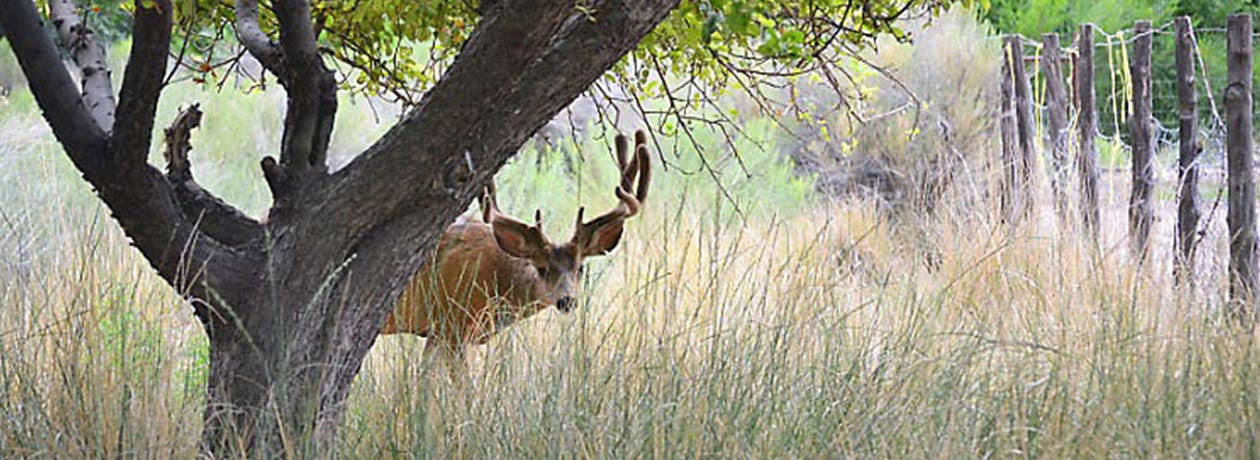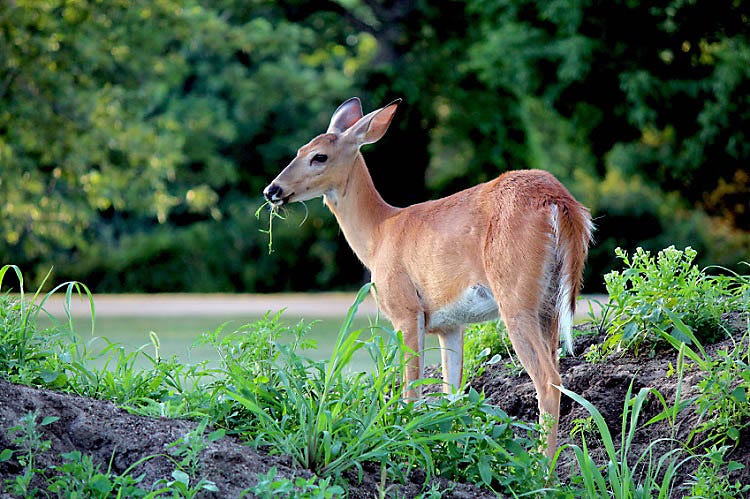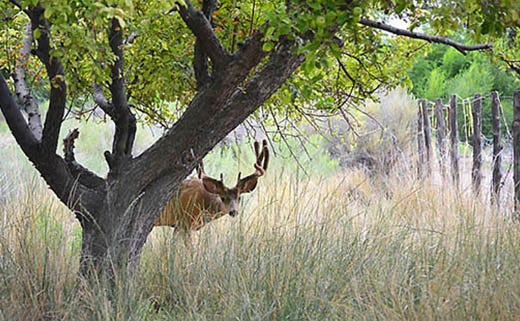Solutions to Keep Deer off a Property

First time homeowners and people who are new to gardening may be excited when they first see deer in their yards. However, after the deer work through their property those homeowners might find their fruit trees chewed to nubs and their garden destroyed.
Deer can quickly decimate decorative trees, shrubs and fruit trees. These animals also make short work of vegetable gardens. Deer can also carry ticks that spread Lyme disease, a debilitating illness that affects both people and dogs.
For these reasons, many people prefer to keep deer completely off their property.
Eliminate Deer Attractants
Harvest produce from a garden or fruit tree as soon as it is ready. This will prevent deer from seeing (or smelling) something tasty and deciding the yard is an all-you-can-eat buffet.
Keep Deer-Attracting Plants Closer to the Home
This is especially important during spring when mother deer are providing food for their fawns. They enter yards in search of delicious plants that are high in protein and nutrients. During this time, deer love to feast on English Ivy and a variety of vegetable plants like peas and lettuce. Any fruit-bearing trees or vines will also be targeted. Deer enjoy the sweet taste of strawberries and peaches as well as many flowers, including pansies and impatiens. Grow these plants closer to the home and within eyesight of the windows. Even hungry deer are reluctant to come so close to a human dwelling.
Maintain the Landscape

Now comes the part that every trapper dreads: releasing it without getting attacked. Fortunately, wanting revenge is a human emotion and an animal’s instincts will drive it to seek cover and safety once released. Unfortunately, the animal may feel that the safest place for it in this new environment may be the cage it is in, and it may take some time before it gets brave enough to explore its options and find a more suitable hideaway. Remove the blanket if necessary, so that it loses confidence in its current enclosure and will want to find a more secure one, and try backing away to help bolster its courage.
Depending on the cage design, the door will open in different ways, but most will allow you to unlatch it without putting your hand too close to the animal. If the gloves prove to be too cumbersome for the task, see if the release mechanism can be manipulated with a pole, allowing you to stay some distance away. Either way, you will want to remain behind the cage, so that it opens in the opposite direction, facing foliage the animal can retreat to and hide within. When you return home, use rubber gloves to disinfect the cage with a solution that is 1 part bleach, 9 parts water. This will remove your scent and any germs the previous occupant may have left behind, leaving it ready for reuse in case your pest problem persists.
Add levels to the yard
Deer don’t enjoy climbing up or down steep or sheer slopes. A yard that seems difficult to navigate can deter deer immediately. Sunken beds, terraces and stacked chopped wood can be added to the landscape to prevent deer from entering too far into the yard. When deer see these, they are afraid to jump or climb on them and will find somewhere else to graze. Keep potted plants up on the deck or porch, deer will likely not attempt to climb stairs to reach them.
Let the dog spend plenty of time in the yard
Chances are if the dog spots a deer, it will bark. The deer will run and may eventually decide the yard isn’t a safe place to graze.
Use plants and shrubs as taste-based repellents
Deer rely heavily on their sense of smell. If something smells unappealing to them, they will avoid it. Deer develop preferences for plants and trees that taste good, just like humans do. If you can make the trees unappealing to a deer’s sense of smell and taste, it will likely go elsewhere for food. For these reasons, some homeowners plant pungent herbs and other plants around the trees and shrubs they want to protect. This may help to a degree, but you will find that deer, like people, have different preferences. You could accidentally plant something that the deer find absolutely delicious! For these reasons, some homeowners plant pungent herbs and other plants around the trees and shrubs they want to protect. Some deer-repelling plants with strong aromas include lavender, catmint, garlic or chives. Because they are thorny, roses are sometimes a good choice as well, but some deer find roses to be a wonderful snack. With any type of deer-resistant plants, you’ll learn by trial and error which plants are not favored by the deer where you live. Try asking other homeowners and gardeners to get an idea of the plants they use to repel deer.
Use hedges to create a border
Boxwoods and other thick hedges can be used to keep deer out. These plants line the yard’s perimeter and act as a border or a wall, deterring deer from crossing through. Because deer can’t see through the hedges into the yard, they may decide to skip the yard and head elsewhere because it’s too risky for them to proceed. Keep hedges well maintained so they stay full and continue to block the view into the yard.
Build a fence
Adding a strong, tall fence all the way around the property may keep most deer out. However, deer can jump quite high. A good rule of thumb is to build the fence at least eight feet tall and don’t leave any gaps wider or taller than six inches. Keep the fence well-maintained so that deer don’t find a way to squeeze in.
Apply proven deer repellents
Deer repellent products are effective in obstructing a deer’s sense of smell and taste. Deer Off® is an ideal repellent to apply to the trees because they affect both senses. This repellent emits a scent that reminds deer of a decaying animal. This signals deer and other animals to vacate the yard. Additionally, the repellent tastes like garlic which makes it unappealing to deer. The Department of Natural Resources at Cornell University states that these repellents “can reduce browsing on individual shrubs or trees by 50-75%. ” Deer Off® lasts up to 90 days with one application. For best results, you should treat your trees with a repellent before the deer start nibbling on them. They typically feed on trees in the autumn through early spring (approximately October through February). During this time frame, female deer are most hungry. When you use deterrents early, before deer find grazing sites, they learn early in the season to avoid your plants and are less likely to investigate the area again.
Install plant nets or tree wraps
Tree wraps are also commonly used to prevent deer from nibbling and rubbing their antlers on trees. However, wraps are not attractive, and sometimes deer are smart enough to knock them off the tree. If you use wraps to prevent antler rubbing, be sure to install them in the fall when deer start marking their territories. Netting can also be used to prevent deer from getting at the plants. Place the net over bushes, across fruit trees and overtop bulbs to protect them from deer. The nets allow the plants to still get water and light, but keep them protected. It’s especially important to wrap or cover young plants as they are in their most vulnerable stage.

A Plan to Repel Deer
Deer are smart, much to the frustration of homeowners who value their trees and landscaping. However, by understanding deer and learning what they like and dislike, you can take action against their destructive habits. With our deer-repellent products from Safer® Brand and these other ideas, you can protect the trees and other valuable plants from these and other animals.
